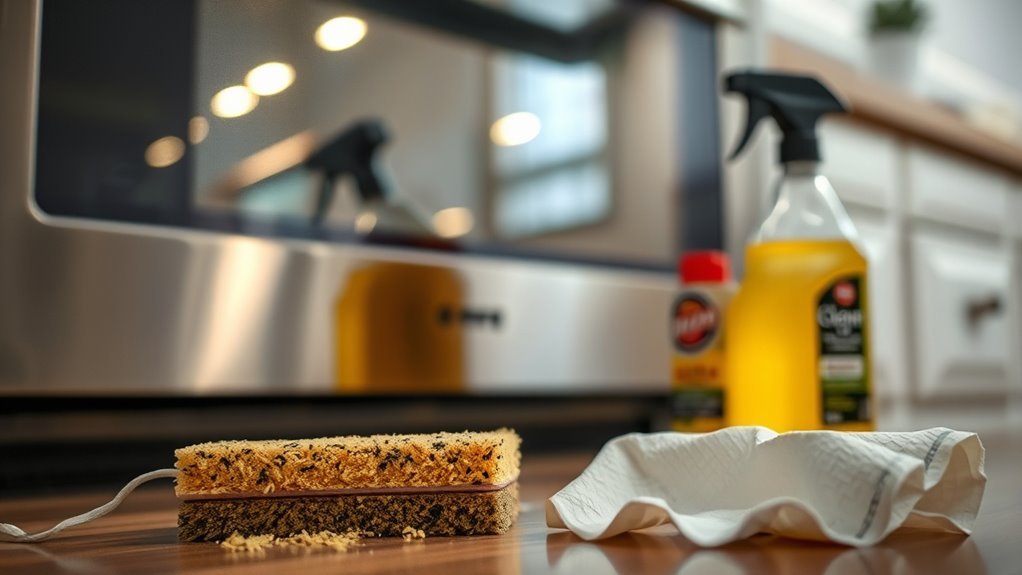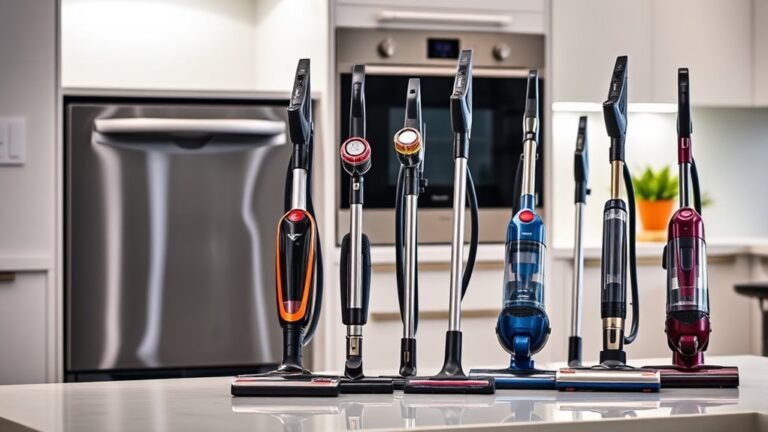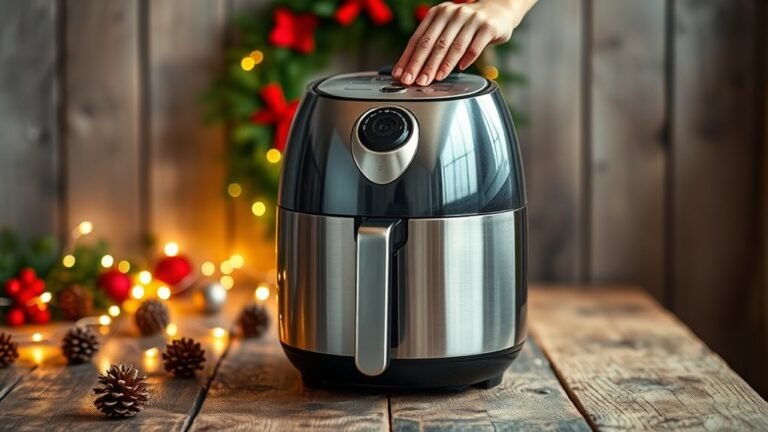Mistakes to Avoid When Cleaning Your Oven
When cleaning your oven, avoid using harsh chemicals that can damage surfaces and shorten its life. Don’t ignore the manufacturer’s instructions—they’re designed to protect sensitive parts. Skip abrasive scrubbing tools that scratch the interior. Always remove oven racks before cleaning and guarantee proper kitchen ventilation to avoid inhaling fumes. Avoid excessive water inside the cavity and don’t use cleaners on self-cleaning ovens. Keeping these tips in mind helps maintain your oven’s performance and safety. There’s more to learn about proper cleaning techniques for lasting results.
Using Harsh Chemicals That Damage Oven Surfaces
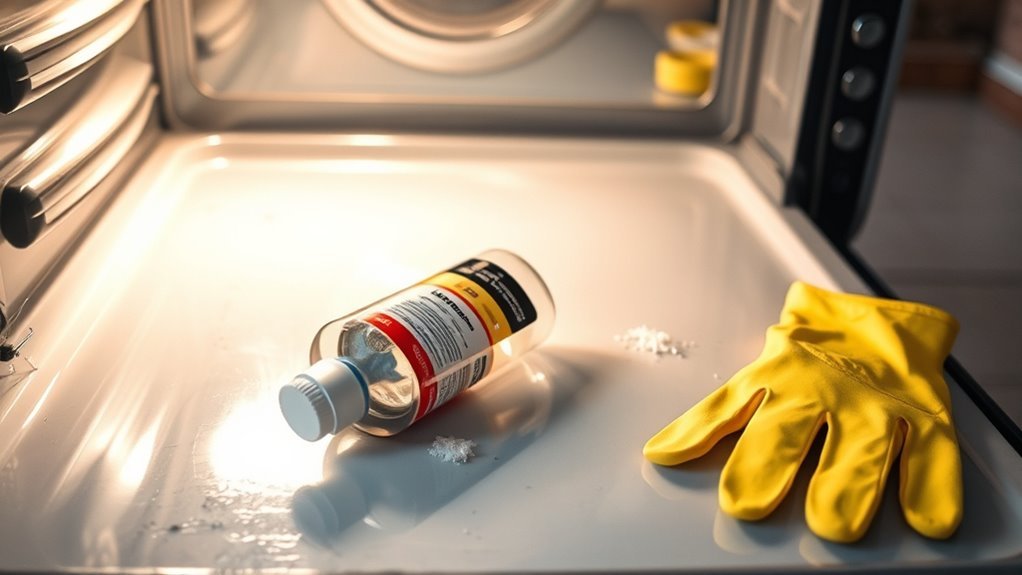
Although harsh chemicals might promise quick results, using them can seriously damage your oven’s surfaces. You’ll want to prioritize chemical safety to avoid corrosion, discoloration, or peeling on your oven’s interior. These aggressive agents often strip away protective coatings, undermining surface protection and shortening the appliance’s lifespan. Instead, opt for milder, oven-specific cleaners or natural solutions like baking soda and vinegar. Always read labels carefully, wear gloves, and guarantee proper ventilation to safeguard yourself and your oven. By choosing safer alternatives, you maintain your oven’s integrity and avoid costly repairs. Protecting your surfaces means your oven stays functional and visually appealing longer, giving you the freedom to cook without worrying about damage from cleaning products.
Ignoring the Oven’s Manufacturer Cleaning Instructions
Choosing the right cleaning products is important, but so is following your oven’s manufacturer cleaning instructions. Ignoring these guidelines can lead to damage and compromise cleaning safety. Manufacturer guidelines are tailored to your oven’s materials and design, ensuring effective yet safe cleaning. Here’s why you should stick to them:
- Protects Oven Components: Specific instructions help you avoid harming sensitive parts like heating elements or coatings.
- Ensures Cleaning Efficiency: Using recommended methods maximizes grime removal without extra effort.
- Maintains Warranty: Following guidelines keeps your warranty valid, avoiding costly repairs.
Respecting these instructions gives you the freedom to clean confidently, knowing you’re preserving your oven’s integrity and your safety.
Scrubbing With Abrasive Tools That Scratch the Interior
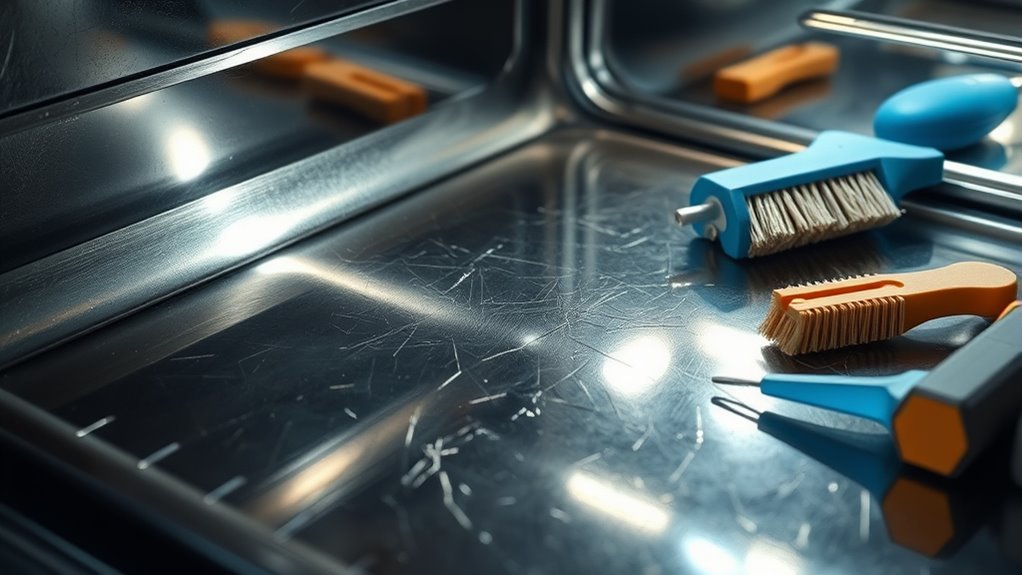
You shouldn’t use abrasive scrubbers that can scratch your oven’s interior surface. Instead, choose non-scratch tools like soft sponges or nylon brushes to protect the finish. This helps maintain your oven’s durability and appearance over time.
Choose Non-Scratch Tools
One essential step in oven cleaning is using non-scratch tools to protect the interior surface. Scrubbing with abrasive pads can leave permanent marks, compromising your oven’s finish and efficiency. To keep your oven free from scratches, choose:
- Non scratch sponges – These effectively lift grime without damaging delicate coatings.
- Gentle brushes – Soft-bristled brushes reach tight spots while preserving surfaces.
- Microfiber cloths – Ideal for wiping down residue without abrasion.
Protect Oven Surface
While using non-scratch tools helps protect your oven’s interior, it’s equally important to avoid abrasive scrubbing tools that can cause damage. Scrubbing with harsh materials not only scratches the surface but also compromises oven protection, leading to costly repairs or reduced lifespan. Prioritize surface maintenance by choosing gentle cleaning methods that preserve your oven’s finish and functionality.
| Abrasive Tools | Impact on Oven Surface |
|---|---|
| Steel Wool | Deep scratches, enamel damage |
| Metal Scouring Pads | Surface roughness, corrosion |
| Hard Bristle Brushes | Surface abrasion, finish wear |
| Rough Sponges | Micro-scratches, dulling |
| Sharp Scrapers | Gouges, coating removal |
Avoid these tools to maintain your oven’s integrity and enjoy hassle-free cleaning freedom.
Neglecting to Remove Oven Racks Before Cleaning
Several oven cleaning mistakes stem from neglecting to remove the oven racks beforehand. Skipping oven rack removal can hinder effective cleaning and may damage both the racks and oven interior. To clean efficiently and maintain your oven’s freedom from grime, follow these key tips:
- Remove racks first: Take out the racks before applying any cleaning agents to avoid trapping moisture and residue.
- Use proper cleaning techniques: Soak racks in warm, soapy water or use a baking soda paste to tackle tough stains without harsh chemicals.
- Dry thoroughly: After cleaning, dry racks completely to prevent rust and guarantee they slide smoothly back into place.
Failing to Ventilate the Kitchen Properly During Cleaning

You’ve got to keep your kitchen well-ventilated when cleaning your oven to avoid breathing in harmful fumes. Poor airflow can lead to headaches, dizziness, or even respiratory issues. Open windows, turn on fans, and use your range hood to keep the air moving and stay safe.
Importance of Proper Ventilation
Because oven cleaners often contain strong chemicals, ensuring proper ventilation during cleaning is essential to protect your health. Without good ventilation methods, harmful fumes can accumulate, reducing indoor air quality and causing discomfort or health issues. To maintain a safe environment, follow these steps:
- Open windows and doors to create cross-ventilation, allowing fresh air to circulate freely.
- Turn on exhaust fans or range hoods to actively remove airborne chemicals and improve air quality.
- Avoid using the oven immediately after cleaning, giving the space time to air out.
Risks of Poor Airflow
Proper ventilation is more than just a recommendation—it directly impacts your safety when cleaning your oven. Poor airflow management traps fumes and heat, creating a hazardous environment. Without adequate ventilation, toxic chemicals from oven cleaners can accumulate, risking respiratory irritation or worse. Additionally, insufficient airflow disrupts heat distribution, causing uneven temperatures that might damage your oven or prolong cleaning time. You want to maintain freedom in your kitchen, not be confined by discomfort or danger. Ignoring ventilation can also increase the risk of fire, as heat and fumes build up unchecked. To protect yourself and your space, you must prioritize proper airflow management during cleaning. It’s a simple step that prevents serious risks and keeps your kitchen safe and comfortable.
Ventilation Tips for Safety
When cleaning your oven, failing to ventilate the kitchen properly can expose you to harmful fumes and increase fire risk. You need to prioritize ventilation to maintain safe air quality and protect yourself. Here’s how to do it right:
- Use your ventilation systems: Turn on the exhaust fan or range hood to remove fumes and keep air flowing.
- Open windows and doors: Allow fresh air to circulate, diluting any chemical odors and preventing buildup.
- Limit exposure time: Clean in short bursts, giving your ventilation systems time to clear the air between sessions.
Applying Excessive Water Inside the Oven Cavity
Although it might seem helpful, applying excessive water inside the oven cavity can cause serious damage to your appliance. Water damage can seep into electrical components, leading to malfunctions or even short circuits. Instead, opt for cleaning methods that use minimal moisture, such as damp cloths or specialized oven cleaners designed to break down grease without flooding the interior. Avoid spraying water directly or using soaking wet sponges, as this increases the risk of corrosion and reduces your oven’s lifespan. By controlling the amount of water you use, you protect your oven’s integrity while still achieving a thorough clean. Remember, less is more when it comes to moisture inside your oven cavity—this approach keeps your appliance safe and functional without compromising your freedom to maintain it effectively.
Overlooking Regular Cleaning Leading to Buildup
Controlling moisture inside your oven helps prevent damage, but keeping your oven clean on a regular schedule is just as important. Overlooking regular cleaning invites grease and food residue buildup, making future cleaning tougher and potentially shortening your oven’s lifespan. To maintain freedom from stubborn grime, focus on these key points for effective buildup prevention:
- Set a consistent cleaning schedule—weekly or biweekly works best to avoid heavy residue accumulation.
- Wipe spills immediately after the oven cools to minimize hardened stains.
- Inspect and clean oven racks and trays regularly to prevent grease buildup that spreads inside the cavity.
Using Oven Cleaners on Self-Cleaning Ovens
Since self-cleaning ovens are designed to handle grime with high heat, you shouldn’t use traditional oven cleaners on them. Many believe applying chemical cleaners boosts the process, but that’s a common self cleaning myth. Using harsh oven cleaner alternatives can damage the oven’s interior coating or release toxic fumes when heated. Instead, rely on your oven’s built-in high-temperature cycle to incinerate residue safely. If you want to speed things up, wipe down loose debris before starting the self-clean cycle. This approach protects your oven’s components and keeps your cleaning routine simple and safe. Trusting the self-cleaning function as intended preserves your oven’s longevity and avoids unnecessary risks from incompatible products.
Häufig gestellte Fragen
How Often Should I Deep Clean My Oven for Optimal Performance?
Did you know that a dirty oven can use up to 30% more energy? For ideal performance, your cleaning frequency should be about every three to six months, depending on how often you cook. Regular oven maintenance not only keeps it efficient but also extends its lifespan. If you use it daily, lean toward every three months. Otherwise, six months is fine to keep your oven running smoothly and energy-efficient.
Can Natural Ingredients Like Vinegar and Baking Soda Clean My Oven Effectively?
You can definitely use natural ingredients like vinegar and baking soda to clean your oven effectively. Baking soda acts as a gentle abrasive that breaks down grease and grime, while vinegar benefits you by cutting through residue and deodorizing. Together, they create a safe, chemical-free cleaning solution. Just make a paste with baking soda, apply it, spray vinegar, let it fizz, then wipe clean. It’s eco-friendly and lets you avoid harsh cleaners.
What Are the Safest Cleaning Products for Ovens With a Non-Stick Coating?
When cleaning ovens with a non-stick coating, you’ll want to use non toxic cleaners to protect the surface and guarantee oven safety. Avoid harsh chemicals or abrasive scrubbers that can damage the coating. Instead, choose gentle, plant-based sprays or natural solutions like diluted vinegar and baking soda. These options clean effectively without compromising your oven’s finish, giving you peace of mind and the freedom to maintain your appliance safely.
How Can I Remove Burnt-On Food Without Damaging Oven Heating Elements?
To remove burnt food without damaging your oven’s heating elements, avoid spraying cleaners directly on them. Instead, soften burnt food using a damp cloth with warm, soapy water or a baking soda paste. Gently scrub with a non-abrasive sponge, steering clear of harsh tools that could harm the heating elements. Always make sure the oven is cool before cleaning, and never use sharp objects that might scratch or damage sensitive parts.
Is It Necessary to Unplug the Oven Before Starting the Cleaning Process?
It just so happens that unplugging your oven before cleaning it is a smart move for oven safety. While some models can be cleaned without unplugging, cutting power eliminates any risk of electric shock or accidentally turning it on. Following this cleaning tip not only protects you but also gives you peace of mind. So, before you start scrubbing, unplug your oven to keep your cleaning process safe and worry-free.
